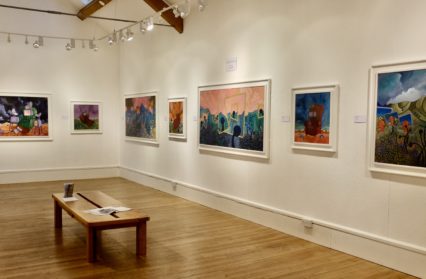Candy Bedworth and Ian Munday review Paradoxes, an exhibition by Ceri H Pritchard showing at MOMA Machynlleth.
Q: How do you know you’re looking at a Ceri H Pritchard painting?
A: It’ll contain a sofa and a TV in surreal juxtaposition.
Pritchard has said that his themes revolve around the use of the everyday in unfamiliar situations. Certainly, his on-going love for film-maker David Lynch and painter Max Ernst is still very much in evidence. Aberystwyth-based critic and academic Harry Heuser has commented that he was too quick to label Pritchard’s paintings ‘neo-surrealist’, but it’s nigh on impossible to comment on these works without any reference to this art history label.
In these paintings, every canvas is littered with uneasy family groups, sofas, easy chairs that look anything but comfortable, lamps with no light, and looming, giant ‘viral’ forms in pulsing colours which seem to warn of environmental catastrophe. This exhibition is a cacophony of dense, bold colour.
Almost every review or gallery guide begins by making reference to Pritchard’s famous artist parents: Gwilym Prichard and Claudia Williams – it seems both we, and Ceri, cannot escape this link.
Pritchard has said: “The paradoxical nature of painting, a process that can involve hours of solitary work to represent a singular instant of lived experience, provides me with opportunities to address deep-seated traumas and recover hidden memories. ” Are parts of this exhibition a glimpse into the memory of a childhood with perhaps our most celebrated and famous Welsh art couple?
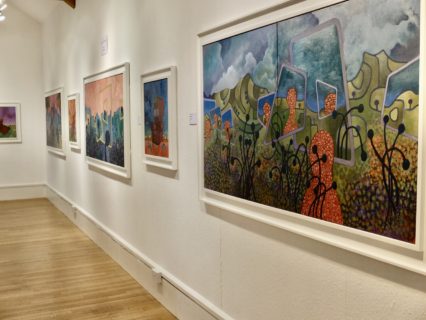
Gwilym Prichard and Claudia Williams and their four children were widely travelled, and moved incessantly. It is estimated that the family had over 30 homes during childhood years, each a wreck that needed doing up. Creature comforts were often sacrificed for art supplies. This might sound like a rollicking adventure, but it could also have been quite a lonely and disjointed experience. In the 1970s father Gwilym was drinking heavily, with mother Claudia holding the family together.
Pritchard has said that his parents fierce work ethic informs his own practice. But how much of their work informs his? A Claudia Williams painting has an intimacy and a welcoming in, a celebration of the ordinary. A Gwilym Prichard painting gives us a vast landscape, but one still touched by human hands, with farms, fences or old stone walls. In a Ceri H Pritchard work these vital and passionate elements have transmuted to quite scary situations, chaotic and untethered from reality. We may recognise a domestic scene, but do we want to enter? Menace and unease are the currency here.
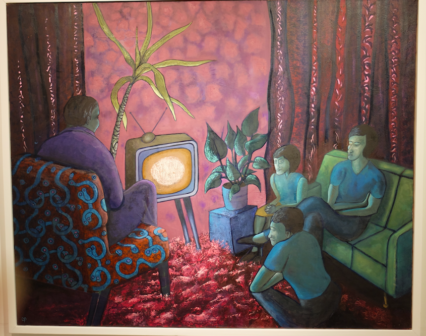
This is a huge exhibition – running through the two main MOMA galleries and involving 30 works, all oil on canvas, and made up of small, medium and large canvases. The exhibition is uncurated and undated, but perhaps the unsure footing that gives you is deliberate. If these images are drawn directly from the subconscious, then time there is immaterial, overlapping or even non-existent.
The subconscious is of course our surrealist playground, but the extremity of some of Pritchard’s fantastical paintings give us no way in, no way to understand or communicate. We are watching the painter paint, rather than finding ourselves in conversation with him. Old TV sets and floral sofas may be the vocabulary of Prichard’s childhood, but we felt like Peeping Toms on his subconscious rather than engaged visitors. The suggestions of environmental global disaster are unmistakeable, but seen through the lens of 1950’s atomic annihilation imagery.
Some have suggested that Pritchard’s art has been influenced through using psychotropic drugs whilst living in Mexico. Shamanic psilocybin is used in some cultures to achieve a spiritually transformed state. Are some of these images the leftover chemical experiments of his younger days? That would make these paintings direct messages from the collective subconscious. Are we listening?
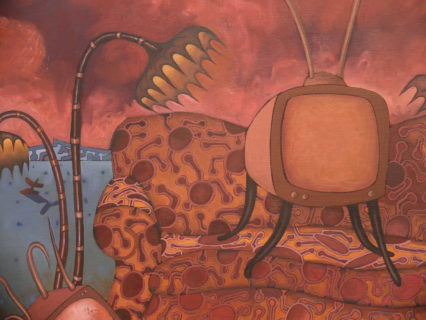
So, let’s get the surrealism reference out of the way. If surrealism was a political and aesthetic response to the technical brutality, and social upheaval that occurred through the 1920s, 1930s and 1940s, why is Pritchard still ploughing that furrow today? Surrealism had its roots in philosophy and psychology and was a highly significant revolutionary movement. In painting it radically broke rules and expectations and surely paved the way for Abstract Expressionism, Hyper-realism and Pop Art. But Pritchard was not born until 1954, by which time Surrealism was in decline and Abstract Expressionism in the ascendancy. Are we getting bogged down in art history timelines? We can’t help but think that painting surrealist works today is the equivalent of being able to paint like Raphael: having that skill would not make you a Renaissance master. But perhaps in these Covid-filled, planet-burning, millionaires colonising space end-times, Surrealism IS ripe for a resurgence?
Looking at the contents of these works, repetition most definitely plays a significant role and many canvases boast five to ten fat-bodied old television sets, with aerials that resemble the reproductive organs of flowers such as lilies. In the Metamorphosis series repeats reoccur, this time with flat-screens. Do these later works reflect advancements in technology, but not in our obsessions and our failings?
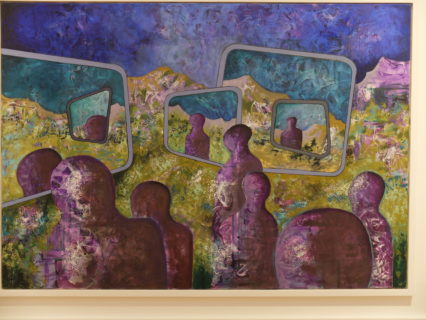
Agnosia and Alexia is a landscape canvas presented in shades of greens, turquoises and blues, with faceless purple figures reminiscent of Gormley statues; the colour palette of this work is pleasingly harmonious. Yet what does it mean? Agnosia is an inability to interpret sensations and hence to recognize things. Alexia is the inability to read written words or letters. Both can be as a result of brain damage or trauma. How does the title relate to the images? We don’t know. Pritchard has said that the titles of his work can be random, or even suggested to him by friends. Does it matter that we don’t understand the connection between title and painting? No of course not, but it leaves us slightly perplexed.
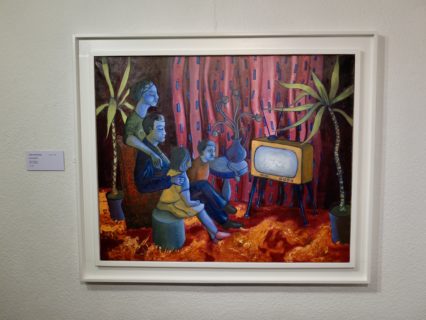
There are four works which are purely figurative. The Late Show and An Evening In are two domestic scenes of families watching television. Their feet rest upon (or almost get sucked within) a swampy, shaggy, lava-like rug. Exotic pot plants tower over them. We see static sallow faces, staring into screens which reflect that cold blue screen light across the canvas. They seem less a celebration of family, more a criticism. Is Pritchard mocking our modern obsession with watching the world through our screens large and small? What the works do include are Pritchard’s familiar motifs of television screens and sofas, though for once their purpose seems quite literal.
The other two figurative works are The Black Dog and The Dog. Here are two landscapes with male figures and a black dog. The men, who look and dress alike, wander through a desolate landscape, dominated by a sky that seems to be on fire. The tops of their heads are deliberately cut off, like a badly snapped family photo. The animal is a mystery – a priapic dog, who defies the classic compositional technique of depth of field. Are these the black dogs of depression? Is that too clichéd? However with a palate of green and blue landscapes, orange skies and green tinged skin one feels the influence here of Fauvism.
Works like Battle have a sinister post-apocalyptic feel to them. These definitely conjures science-fiction associations, like covers of 1950’s sci-fi comics, with growths, plants, organisms and terrains definitely suggesting the extra-terrestrial.
If you are a fan of Ceri H Pritchard, then this is a must-see exhibition. It’s huge. In the MOMA introduction to the exhibition, Pritchard states: “The iconography of my paintings – derived from the domestic mundane – responds to the absurdities of modern life Unresolved tensions and a sense of bewilderment, dislocation and unease are central to my work.” This exhibition will certainly leave you disturbed, with more questions than answers, but then that’s probably the point.
Paradoxes is showing at MOMA Machynlleth until 13 November 2021.
Support by:


